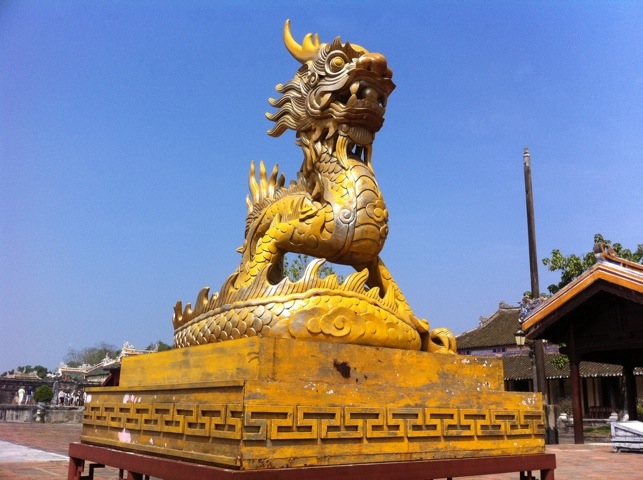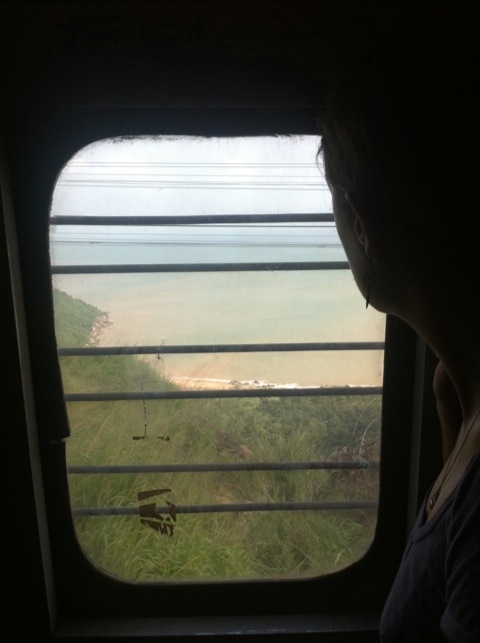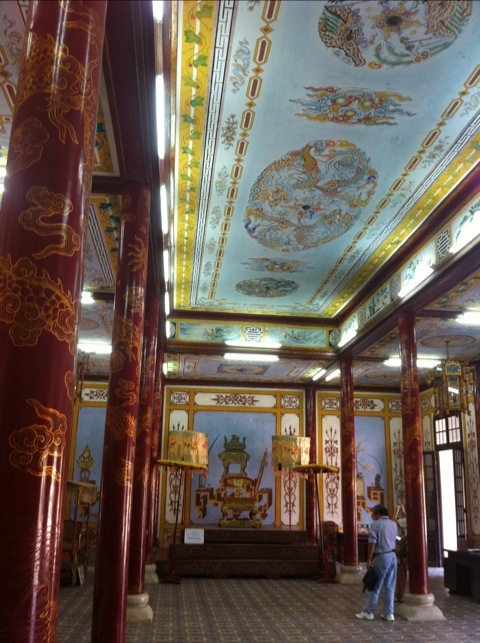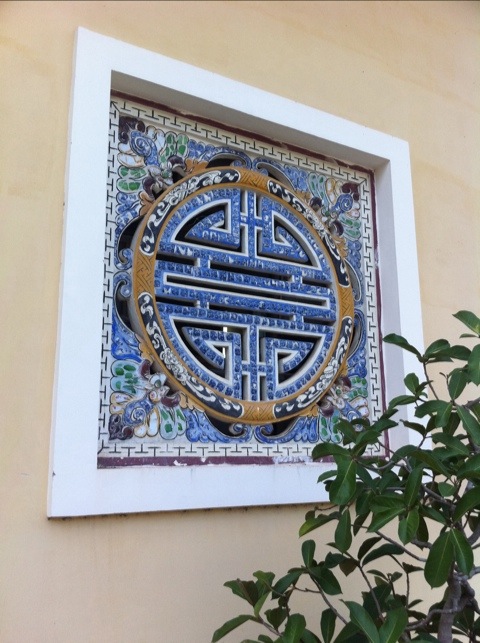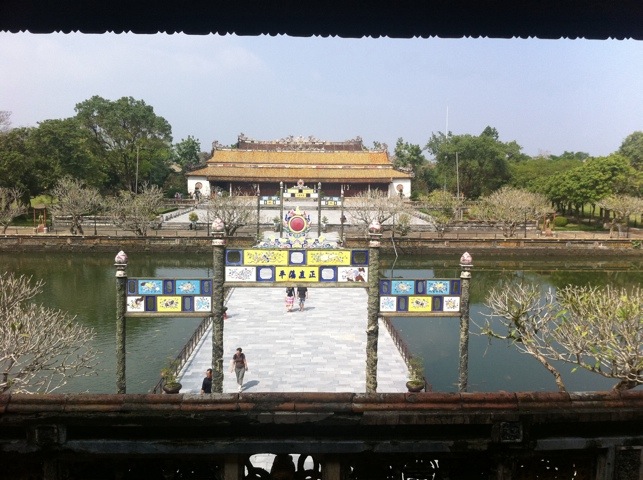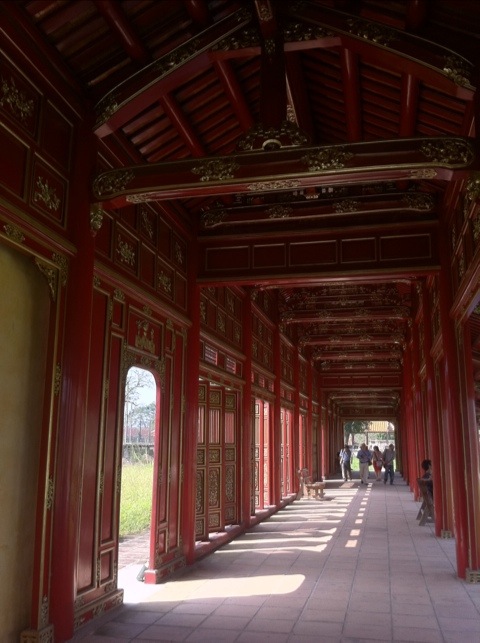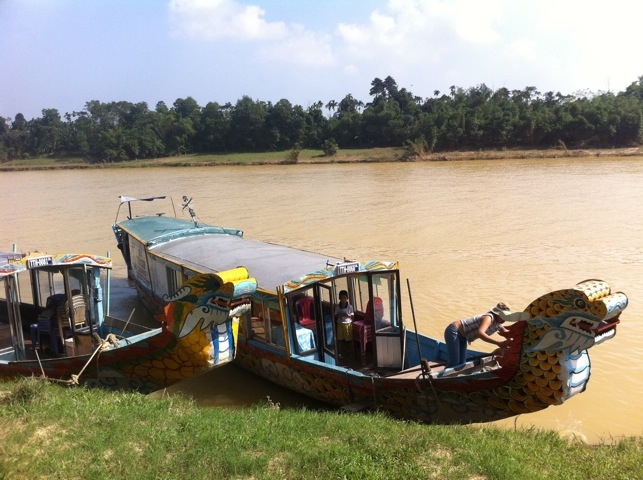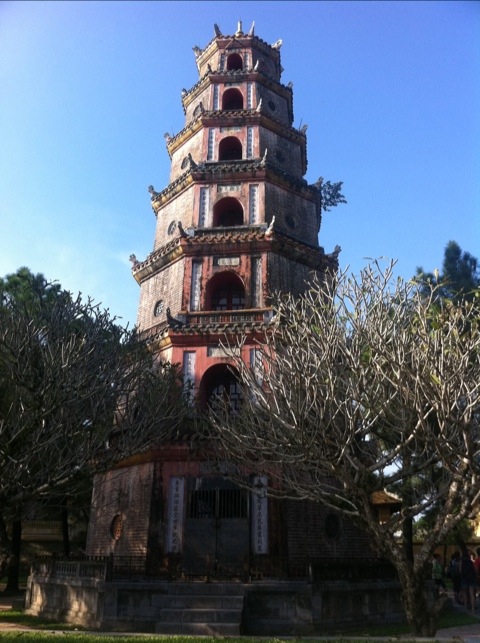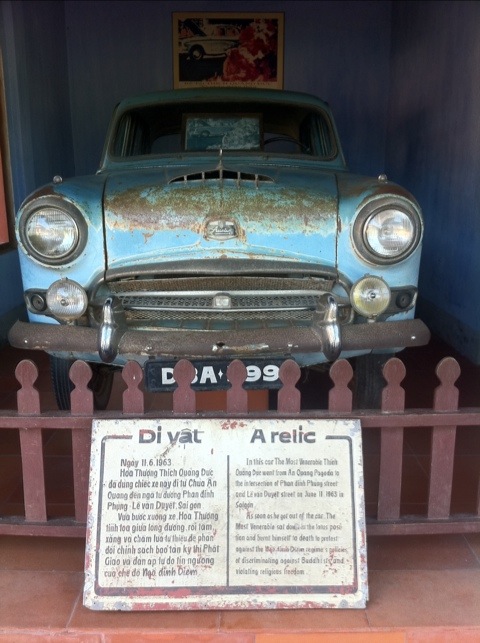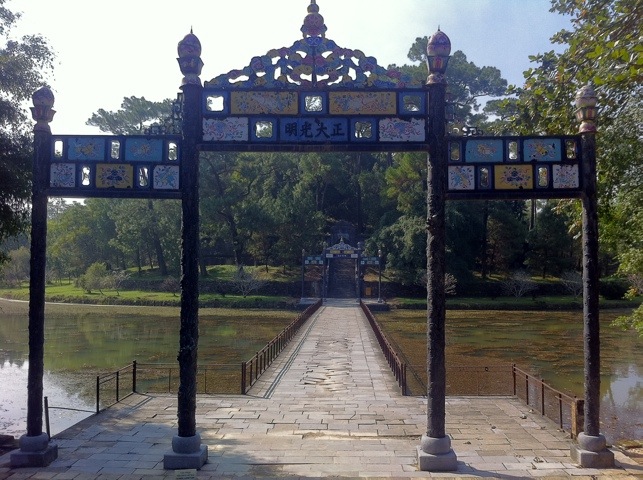We’ve had quite a varied experience of actually travelling in Vietnam so far. Trains are very good. We’ve now been in ‘hard’ and ‘soft’ sleepers (the only difference is really 6 vs 4 berths) but they’re pretty luxurious compared to India, with compartment doors – and even a duvet! The only thing I miss is the brilliant organisation of Indian Railways, with its printed seating reservation charts posted on the outside of the train and the sheer scale of the operation. These feel like a kids toy in comparison! The views however have been fantastic, with a stunning costal journey up from Hoi An alongside stark cliff edges and the shimmering sands of deserted beaches.
We’ve also now taken motorbikes for the first time, in the form of a slightly surprising station pickup from our latest guest house. I think it’s fair to say we were somewhat skeptical about our chances of survival when we trudged off the train with our pile of backpacks and day bags (and a large bundle of clothing to post back home) to find a couple of guys on scooters waiting for us. It turns out that it works quite well with a backpack jammed in the footwell and us clinging on, seated behind the driver (fear not, we had helmets!). Oh, and it turns out you don’t need to wrap your arms around the guy (unless of course you want to) – there are handles by the seat for that! Next time I will avoid also having a bag of clothes though, which provided an entertaining balancing challenge, all the more exciting given this was my first motorbike journey since I was in Brazil 10 years ago!
It’s a bit strange the absence of rickshaws here – we became so used to them in India that the idea of stepping into an A/C taxi seems, well, foreign (but I guess that’s fitting!) Since they’re pretty much the only convenient way of going longer distances in the cities, we’ve had to adapt – but although much cheaper than the UK, they’re still a painful expense, so we’ve been using our feet wherever we can.
We’ve also dabbled in the local buses, which are famously exploitative of tourists. For our journey from Da Nang to Hoi An, we knew the fare should be 15,000 VND (50p) – which is what the locals were handing over – but the ticket boy insisted on us paying 40,000, threatening to kick us off the bus if we didn’t pay when we stood firm. We think this is in part because he’d already conned some other tourists on board and would have to refund them too. Reluctantly (but still cheaper than a taxi), we paid up. On the journey back, we paid the correct fare, showing that at least some of the fare collectors are honest.
Whichever way we’ve travelled, the view out of the window has been very different to India. The dusty plains and palm trees have been supplanted by acres of small plots of land, with rolling green mountains behind. Oddly, dotted amid the vegetation everywhere in the countryside are lots of graves – presumably family members buried on their family vegetable plot? It was even eerier to see many of these underwater in the flooding near Hoi An – I guess that’s just a side to the monsoon you don’t think of.
As we’ve gone on, at times its been hard to remember we’re in Vietnam and not China. Many people look ethnically Chinese, and their language has a Chinese accent to it; the detail of the temples and pagodas are also in the vibrant hues of reds and glistening golds we recognise, and there’s definately a fair few blue dragons on the rooftops. The saving grace is that the script uses the Latin alphabet, and so we’re slowly beginning to recognise and pronounce some of the words, a real challenge for us in Beijing.
The guide book optimistically says Hue has “stood aside from the current economic frenzy … A small peaceful city, full of lakes, canals and lush vegetation, all celebrated in countless romantic outpourings by its much esteemed poetic fraternity.” If the world of work taught me one thing, it’s to manage expectations – and ours were truly set by this description. So it came as somewhat of a disappointment to find a noisy, traffic ridden strip (euphemistically named the ‘South Bank’), surrounded by high rise hotels and a view across the river to huge neon adverts for the local beer company. Perhaps the literati have been drinking too much of that stuff! As we found, there is a nice part to the city – but it’s a stretch to say the place as a whole is peaceful, and it certainly isn’t small either.
Hue is famous for its citadel, whose 11km of walls are still intact, along with a decent, wide moat to keep intruders out. Again there are strong echoes of Beijing here, with the Imperial City strikingly similar to its Forbidden City, with a nested Forbidden Purple City for the emperor and his concubines, and the red flag flying in front similarly positioned to where Tienanmen Square would be with its portrait of Mao. This part of the city is indeed lovely – although partly destroyed by bombing in the war, what remains is a mixture of quiet and ramshackle gardens intermingled with wonderfully restored buildings and stunning ornamentation. These include an intricately patterned theatre; majestic corridors of teak beams with bright red and gold decoration; yellow dragons gleaming in the sun; and stunning blue and white decorative emblems made from pieces of embedded ceramics. Hidden among these were also a couple of Geocaches which we delighted in finding – one with a huge frog living next to it!
The citadel also has an entertaining ‘digital reconstruction’ of what it once looked like, funded by aid from South Korea (and heavily sponsored by Samsung). It was interesting to see how the jigsaw of ruins previously fitted together, but the highlight that made me laugh out loud was how the video ended with a computer rendered cut scene of the emperor sitting before the imperial court with his mandarins bowing before him. Such was the style of the digital graphics, the panning camerawork, and the massed drumming in the background, it could have come straight from the pre-fight intro sequence to any number of ‘beat-em-up’ computer games, say Tekken. I was just expecting a “3-2-1 fight” message on screen when the closing credits came up!
Other than food (which I’ll leave to
Laura as our culinary features editor), the city’s other main attraction is the wide Perfume River, winding its way through the centre, its banks home to a plethora of temples, pagodas and mausoleums. Fragranced it was (fortunately) not, it was one of the murkiest waterways we’ve been on, with lots of family-run operations dredging for stones and gravel from the bottom for use as building materials. We hired a boat for a day and took a pleasant trip south along to some of the sights, which really were worth seeing. There were a couple of very tranquil mausoleums set in acres of parkland, one with a gorgeous lake surrounding the burial mound. We also visited a Buddhist pagoda, with a working monastery, and former home to Thich Quang Duc, the monk who famously set fire to himself in front of the world’s press in Saigon in protest at President Diem’s regime. The infamous photo can be seen below, along with the car he drove there in.
On reflection, there is actually one obvious contrast with China – for despite Vietnam’s troubled past, its modern persona is very much free and open, a marked difference to the visible repression we saw on the streets of Tibet, or the more subtle control over Tiennamen Square, and the mind games of Internet censorship in the ubiquitous Internet cafes heaving with young people playing online games. In that sense, here’s hoping this is a path in which China can follow Vietnam rather than the other way round.
Simon

